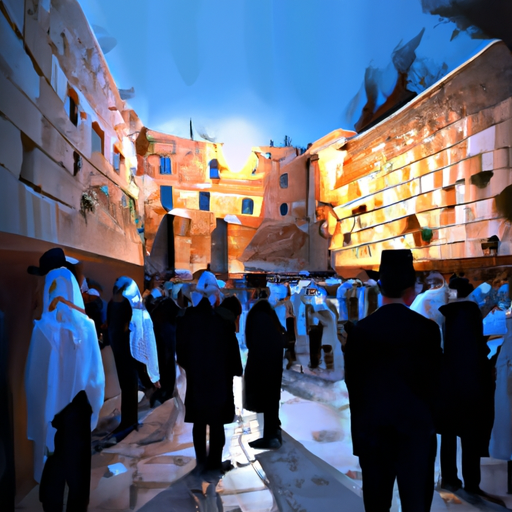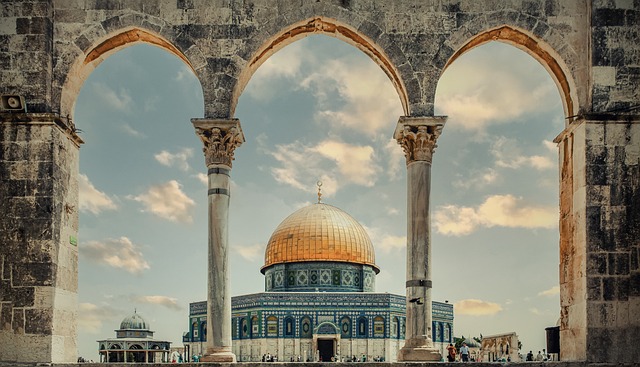A journey through the historical landmarks of Jerusalem, exploring the city's rich tapestry of cultures, religions, and histories. This blog post takes you on a tour of Jerusalem's most iconic sites, from ancient temples and sacred sanctuaries to inspiring monuments and architectural marvels. Dive into the past and discover the stories behind these landmarks that continue to shape Jerusalem's unique cultural identity.
The Western Wall: The Last Vestiges of a Sacred Sanctuary?
The Western Wall, also known as the Wailing Wall, is arguably one of the most significant historical landmarks in Jerusalem. This ancient structure holds immense religious and historical significance for the Jewish people. It is believed to be the last remaining vestige of the Second Temple, a sacred sanctuary that was destroyed by the Romans in 70 CE. The Western Wall has become a place of worship and pilgrimage for Jews from all over the world, who come to pray and connect with their heritage. It serves as a tangible link to the past and a symbol of resilience and faith.
Standing in front of the Western Wall, one cannot help but be awed by its grandeur and the sheer weight of history it carries. The massive stones that make up the wall are a testament to the architectural prowess of the ancient builders. Each stone seems to whisper stories of a bygone era, of triumphs and tribulations, of a people who refused to be defeated.
Visitors to the Western Wall often engage in a deeply spiritual experience. Many write prayers or wishes on small pieces of paper and tuck them into the crevices of the wall, believing that their requests will be heard and answered. The wall has witnessed countless tears shed in times of sorrow and joyful celebrations in times of triumph. It is a place where the past and present converge, where the weight of history is palpable.

A captivating image of the Western Wall, filled with devout worshipers engrossed in prayer.
Is the Dome of the Rock Just a Beautiful Structure or More?
The Dome of the Rock is undeniably a stunning architectural masterpiece, but its significance goes far beyond its aesthetic appeal. This iconic landmark holds immense religious and historical importance for multiple faiths. Situated on the Temple Mount in Jerusalem, it is believed to be the site where Prophet Muhammad ascended to heaven, making it one of the holiest sites in Islam. The dome's shimmering golden exterior and intricate tilework make it a sight to behold, attracting visitors from all over the world.
But the Dome of the Rock is not just a beautiful structure; it is a symbol of coexistence and shared history. The site upon which it stands is also revered by Jews, as it is believed to be the location of the First and Second Temples. For Christians, it holds significance as the place where Jesus is said to have taught and performed miracles. The Dome of the Rock stands as a testament to the complex and intertwined nature of religious history in Jerusalem.
Inside the dome, visitors are greeted by a breathtaking interior adorned with vibrant mosaics and intricate calligraphy. The centerpiece is the sacred rock, known as the Foundation Stone, which is believed to be the spot from which the world was created. This rock holds deep spiritual meaning for both Muslims and Jews, further highlighting the shared heritage of the site.
Take a daily tour in Jeruslaem with bein harim tours to enjoy all of it.
Via Dolorosa: 'The Way of Suffering' or the Pathway to Redemption?
The Via Dolorosa, also known as the "Way of Suffering," is a historic and sacred pathway in Jerusalem that commemorates the final journey of Jesus Christ. This path holds immense religious significance for Christians worldwide, as it is believed to be the route Jesus took while carrying the cross to his crucifixion. Walking along the Via Dolorosa is an experience that evokes a profound sense of reflection and contemplation.
The Via Dolorosa is marked by a series of stations, each representing a specific event that occurred during Jesus' last hours. Pilgrims and visitors can follow in his footsteps, pausing at each station to reflect on the suffering and sacrifice endured for the redemption of humanity. The atmosphere is filled with reverence and solemnity, as people from different backgrounds come together to pay homage to Jesus' journey.
While the Via Dolorosa is often associated with suffering, it also serves as a pathway to redemption and spiritual renewal. It is a powerful reminder of the love and forgiveness that Jesus embodied, and the hope that his sacrifice brings to believers. Walking along this historic route allows individuals to connect with their faith on a deeper level and find solace in the message of salvation.

A poignant image capturing the Via Dolorosa, with pilgrims walking the path Jesus is believed to have taken on his way to crucifixion.
The Tower of David: A Monument to Jerusalem's Multifaceted History or a Symbol of Its Unyielding Spirit?
The Tower of David, also known as the Jerusalem Citadel, stands as a majestic monument that embodies the rich and multifaceted history of Jerusalem. This ancient structure has witnessed the rise and fall of empires, the conquests of various civilizations, and the resilience of the city throughout the centuries. It serves not only as a physical fortress but also as a symbol of Jerusalem's unyielding spirit in the face of adversity.
With its strategic location overlooking the Old City, the Tower of David offers a panoramic view of Jerusalem's historical landscape. From its walls, one can see the remnants of different eras, including Roman ruins, medieval architecture, and Ottoman influences. Each layer tells a story, weaving together the tapestry of Jerusalem's diverse past.
Beyond its historical significance, the Tower of David serves as a cultural hub that houses the Tower of David Museum. This renowned institution showcases archaeological artifacts, exhibitions, and multimedia presentations that bring Jerusalem's history to life. Visitors can immerse themselves in the city's past, gaining a deeper understanding of its complexity and the forces that have shaped it.
Moreover, the Tower of David has become a symbol of Jerusalem's unyielding spirit. Despite countless conquests and conflicts, the city has endured and preserved its identity. The tower stands as a testament to the resilience and determination of its inhabitants, who have rebuilt and restored the city time and time again.
Jerusalem's historical landmarks offer a fascinating glimpse into the past, providing a deeper understanding of the city's complex history and diverse cultural heritage. They stand as a testament to the city's resilience, its spiritual significance to many, and its ability to harmoniously blend ancient traditions with the modern world. As we conclude our journey, it becomes abundantly clear that these landmarks are not just historical structures, but living, breathing entities that continue to resonate with the heartbeat of Jerusalem.











